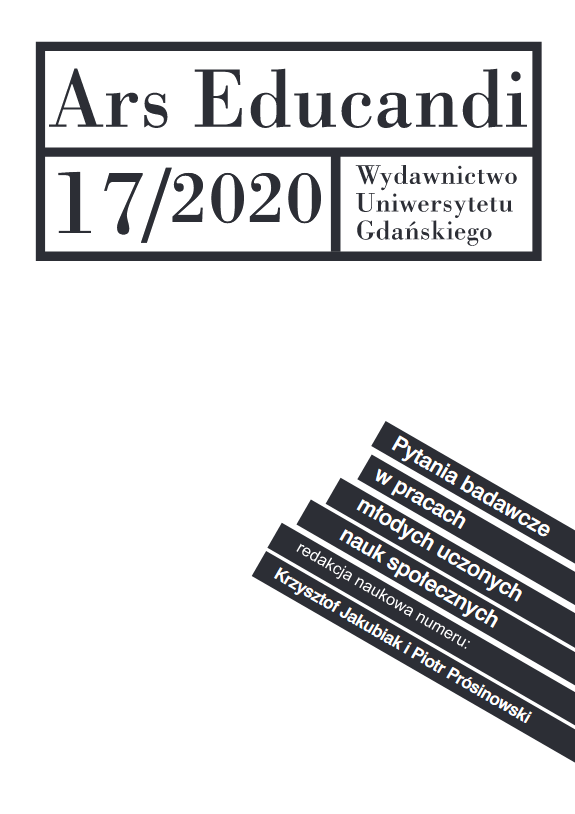"Always on" generation - psychological and social functioning of teenage technology media users
DOI:
https://doi.org/10.26881/ae.2020.17.02Keywords:
technology, newmedia, youth, social support, quality of lifeAbstract
There is a number of negative consequences of improper use of mobile phones reported in the literature. On the other hand, technological progress opens up wide opportunities.
The aim of this study is to examine the relationship between the problematic use of a mobile phone by young people, social support and quality of life, as well as an attempt to answer the question whether young people accurately predict the time spent in front of the phone screen.
The study was attended by 453 people aged 16-19. In order to examin participants, a phonholism questionnaire, the Berlin Social Support Scales, KIDSCREEN-27 questionnaire and The QualityTime application was used.
The results of the research indicate a significant overestimation of the time spent by young people with the telephones. However, the declared time was a stronger predictor of phonholism. There is also a visible connection of excessive use of a smartphone with the search and demand for social support. The phone turns out to be a powerful tool for maintaining peer contacts. People who report more problems with using the telephone also report weaker results in learning and discomfort at school. There were no differences in physical well-being.
Downloads
References
Dębski, M., 2016, Nałogowe korzystanie z telefonów komórkowych. Szczegółowa charakterystyka zjawiska fonoholizmu w Polsce. Raport z badań, Fundacja Dbam o Mój Z@sięg. https://dbamomojzasieg.com/pobierz-raport/ (11.05.2018).
Gausby, A., 2015, Attention spans. Consumer Insights, Microsoft Canada. https://pl.scribd.com/document/265348695/Microsoft-Attention-Spans-Research-Report (11.05.2018).
Gross, E. F., Juvonen, J., Gable, S. L., 2002, Internet use and well-being in adolescence, Journal of Social Issues, 58(1), 75–90.
Filiciak, M., Danielewicz, M., Halawa, M., Mazurek, P., Nowotny, A., 2015, Młodzi i media. Nowe media a uczestnictwo w kulturze. Warszawa: Centrum Badań nad Kulturą Popularną SWPS.
Hansraj, K.K., 2014, Assessment of stresses in the cervical spine caused by posture and position of the head. Surgical Technology International, 25, 277-279.
Jarczyńska J., 2014, Uzależnienia behawioralne i zachowania problemowe młodzieży. Teoria, diagnoza, profilaktyka, terapia. Bydgoszcz: Wydawnictwo Uniwersytetu Kazimierza Wielkiego.
Kraut, R., Kiesler, S., Boneva, B., Cummings, J,. Helgeson, V.,Crawford, A., 2002, Internet paradox revisited. Journal of Social Issues, 58(1), 49–74.
Kraut, R., Patterson, M., Lundmark, V., Kiesler, S., Mukhopadhyay, T., Scherlis, W., 1998, Internet paradox: A social technology that reduces social involvement and psychological well-being? American Psychologist, 53(9), 1017–1032.
Ledzińska, M., 2002, Stres informacyjny – sposoby radzenia sobie i przeciwdziałania.
W: Heszen-Niejodek, I., Matusiak, J. Konteksty stresu psychologicznego. Katowice: Wydawnictwo Uniwersytetu Śląskiego, 27-40.
Levinson, P., 2006, Telefon komórkowy. Jak zmienił świat najbardziej mobilny ze środków komunikacji, Warszawa: Wydawnictwo MUZA S.A, 13.
Łuszczyńska A, Kowalska M, Mazurkiewicz M, Schwarzer R., 2006, Berlińskie Skale Wsparcia Społecznego (BSSS). Wyniki wstępnych badań nad adaptacją skal i ich własnościami psychometrycznymi. Studia Psychologiczne, 2(44), 17-27.
Mazur, J., Małkowska-Szkutnik, A., Dzielska, A., Tabak, I., 2008, Polska wersja kwestionariuszy do badania jakości życia związanej ze zdrowiem dzieci i młodzieży (KIDSCREEN). Warszawa: Instytut Matki i Dziecka.
Mazur J., Mierzejewska E., 2003, Jakość życia związana ze zdrowiem dzieci i młodzieży — koncepcje, metody badawcze i wybrane zastosowania. Medycyna Wieku Rozwojowego, VII, 35–48.
Park, J., Kim, J., Kim, J., Kim, K., Kim, N., Choi, I., Lee, S.,Yim, J., 2015, The effects
of heavy smartphone use on the cervical angle, pain threshold of neck muscles and depression. Advanced Science and Technology Letters, 91, 12-17.
Pawłowska, B., Potembska, E., 2011, Objawy zagrożenia uzależnieniem i uzależnienia
od Internetu mierzonego Kwestionariuszem do Badania Uzależnienia od Internetu, autorstwa Pawłowskiej i Potembskiej u młodzieży polskiej w wieku od 13 do 24 lat. Current Problems of Psychiatry, 12(4), 443-446.
Prensky M., 2012, From Digital Natives to Digital Wisdom: Hopeful Essays for 21st Century Learning, Thousand Oaks: Sage Publications Inc.
Prensky, M., 2001, Digital natives, digital immigrants. On the Horizon, 9(5), 1-6.
Rozporządzenie Ministra Edukacji Narodowej z 14.02.2017 w sprawie podstawy programowej wychowania przedszkolnego oraz podstawy programowej kształcenia ogólnego dla szkoły podstawowej. Pobrane z: http://isap.sejm.gov.pl/DetailsServlet?id=WDU20170000356 (30.05.2017) [za:] K. Myśliwiec, Programowanie we wczesnej edukacji dziecka autorka, Edukacja – Technika – Informatyka nr 2/20/2017.
Sharan, D., Ajeesh, P. S., 2012, Risk factors and clinical features of text message injuries. Work, 41(Supplement 1), 1145-1148.
Skarżyńska, K., Henne, K., 2005, Internet, kapitał społeczny, szczęście. Kto i dlaczego korzysta z Internetu? Kolokwia Psychologiczne, 13, 172–186.
Small, G., Vorgan, G., 2011, iMózg, Jak przetrwać technologiczną przemianę współczesnej umysłowości. Poznań: Vesper.
Spitzer, M., 2013, Cyfrowa demencja. W jaki sposób pozbawiamy rozumu siebie i swoje dzieci. Słupsk: Wydawnictwo Dobra Literatura.
The WHOQOL Group, 1995, The World Health Organization Quality of Life assessment (WHOQOL): Position Paper from the World Health Organization. Social Science and Medicine, 41, 1403-1409.
Wierzchoń, M. (2009). Koszty poznawcze uczenia mimowolnego. Wydawnictwo UJ, 46-47.
Woronowicz B.T., 2009, Uzależnienia. Geneza, terapia, powrót do zdrowia. Warszawa: Media Rodzina.
Yang, S. Y., Chen, M. D., Huang, Y. C., Lin, C. Y., & Chang, J. H., 2017, Association Between Smartphone Use and Musculoskeletal Discomfort in Adolescent Students. Journal of community health, 42(3), 423-430.
Young K., Rodgers R.C., 1998, The Relationship Between Depression and Internet Addiction. CyberPsychology & Behavior, 1(1), 25-28.

 Academic Scientific Journals
Academic Scientific Journals




